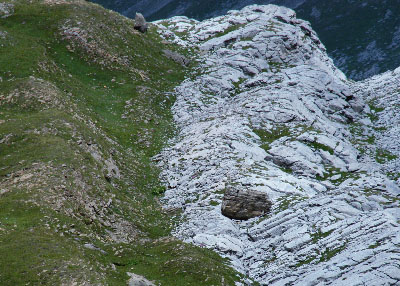 |
|
|
|
|
|
A plant community can be simply defined as the ensemble of plants growing in a specific area. However, a mountaineer will soon recognise that certain plant species can often be found together; they seem to be associated in a way. How do such patterns emerge? As we have seen before, the landscape of mountainous regions represents a small-scale mosaic of different habitat types. In the figure, you can distinguish three habitat types caused primarily by topography: slopes, depressions, and ridges. Each habitat type is characterised by a specific combination of environmental factors such as radiation, temperature, wind intensity, soil moisture, nutrient contents, or duration of snow cover. These combinations of factors form a habitat specific filter or sieve and are represented in different colours in the figure. The plant species occurring in a particular region form the so called "Regional Species Pool". In this hypothetical landscape the Regional Species Pool consists of nine different plant species. Species belonging to the regional pool are adapted to the general environmental conditions of the region but not necessarily to the local conditions in a particular habitat. The environmental filter of a specific habitat expels species that belong to the regional pool but lack the traits required to survive in local conditions, thus preventing them from colonizing the particular habitat. As a result only a subsample of the species belonging to the regional pool occurs in a particular habitat type. This subsample represents a combination of plant species which is characteristic for this habitat type. Since a certain habitat type and its specific environmental filter may occur regularly within a region, the corresponding species combination also will occur repeatedly. Species combinations occurring regularly within a region serve as a basis for the definition and identification of plant community types. Phytosociology is the field of vegetation ecology dealing with the definition and description of plant communities on the basis of characteristic, diagnostic species as well as with the development of a global, hierarchic classification system of plant communities comparable with the taxonomic system.
|
|
Easy, wasn't it? However, the actual story is a little bit more complicated. There are interactions between the plant species and the individuals within the community. Click on the left ridge to see them. A species can facilitate the presence of another species by creating a favourable microenvironment with wind protection and elevated temperatures, for example. Or it may enhance soil nutrient content due to nitrogen-fixing bacteria, which live symbiotically with species of the Fabaceae-family. Such positive interactions between species or individuals are called "facilitations". On the other hand, species or individuals can compete for space or for resources such as nutrients, water, or light. The result of "competition" is a mutual reduction in performance of the species/individuals involved and it may lead to the death of the weaker species/individual, a process called "competitive exclusion". In high altitude ecosystems, facilitation seems to be more frequent than competition (Callaway et al. 2002). Considered in this way, a plant community is not merely a collection of plants but rather an assemblage of populations of different plant species that live in a particular environment and interact with one another as well as with other organisms (fungi, animals, microorganisms). Community members combine to form a distinctive living system with its specific composition, structure, environmental relations, and function. |
|
1 - Two plant communities clearly separated as a result of geological conditions: a closed grassland on the clay-rich rock on the left side and an open community colonizing the crevices of the calcareous rock on the right side. |
Often, the boundary between two habitats is not clear-cut, there is, rather, a continuous alteration of the environmental conditions. In such cases, which are frequent in low altitude environments, discrete plant communities are difficult to delineate. In the alpine life zone, however, the diversity of bedrock types, terrain structures, and the microclimatic conditions lead to distinct habitats that are colonized by well-defined plant communities. This may be a reason why plant communities were already recognised and described in the European Alps in the first half of the 19th century. |
29 August 2011 |
||
| |
||
